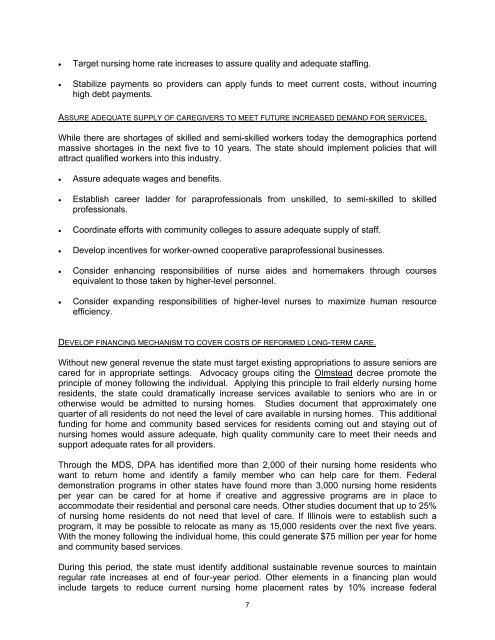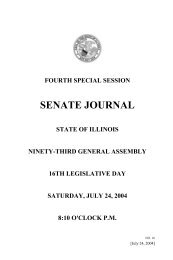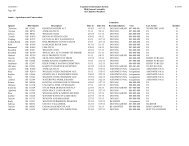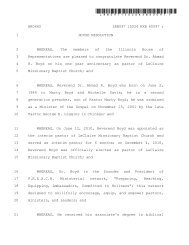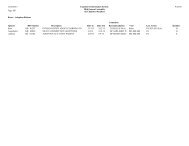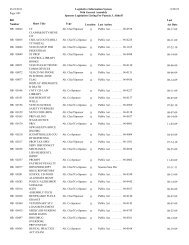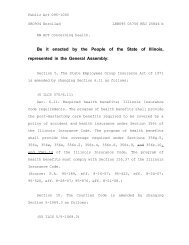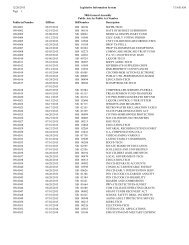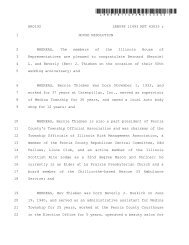Long-Term Care - Illinois General Assembly
Long-Term Care - Illinois General Assembly
Long-Term Care - Illinois General Assembly
You also want an ePaper? Increase the reach of your titles
YUMPU automatically turns print PDFs into web optimized ePapers that Google loves.
• Target nursing home rate increases to assure quality and adequate staffing.<br />
• Stabilize payments so providers can apply funds to meet current costs, without incurring<br />
high debt payments.<br />
ASSURE ADEQUATE SUPPLY OF CAREGIVERS TO MEET FUTURE INCREASED DEMAND FOR SERVICES.<br />
While there are shortages of skilled and semi-skilled workers today the demographics portend<br />
massive shortages in the next five to 10 years. The state should implement policies that will<br />
attract qualified workers into this industry.<br />
• Assure adequate wages and benefits.<br />
• Establish career ladder for paraprofessionals from unskilled, to semi-skilled to skilled<br />
professionals.<br />
• Coordinate efforts with community colleges to assure adequate supply of staff.<br />
• Develop incentives for worker-owned cooperative paraprofessional businesses.<br />
• Consider enhancing responsibilities of nurse aides and homemakers through courses<br />
equivalent to those taken by higher-level personnel.<br />
• Consider expanding responsibilities of higher-level nurses to maximize human resource<br />
efficiency.<br />
DEVELOP FINANCING MECHANISM TO COVER COSTS OF REFORMED LONG-TERM CARE.<br />
Without new general revenue the state must target existing appropriations to assure seniors are<br />
cared for in appropriate settings. Advocacy groups citing the Olmstead decree promote the<br />
principle of money following the individual. Applying this principle to frail elderly nursing home<br />
residents, the state could dramatically increase services available to seniors who are in or<br />
otherwise would be admitted to nursing homes. Studies document that approximately one<br />
quarter of all residents do not need the level of care available in nursing homes. This additional<br />
funding for home and community based services for residents coming out and staying out of<br />
nursing homes would assure adequate, high quality community care to meet their needs and<br />
support adequate rates for all providers.<br />
Through the MDS, DPA has identified more than 2,000 of their nursing home residents who<br />
want to return home and identify a family member who can help care for them. Federal<br />
demonstration programs in other states have found more than 3,000 nursing home residents<br />
per year can be cared for at home if creative and aggressive programs are in place to<br />
accommodate their residential and personal care needs. Other studies document that up to 25%<br />
of nursing home residents do not need that level of care. If <strong>Illinois</strong> were to establish such a<br />
program, it may be possible to relocate as many as 15,000 residents over the next five years.<br />
With the money following the individual home, this could generate $75 million per year for home<br />
and community based services.<br />
During this period, the state must identify additional sustainable revenue sources to maintain<br />
regular rate increases at end of four-year period. Other elements in a financing plan would<br />
include targets to reduce current nursing home placement rates by 10% increase federal<br />
7


